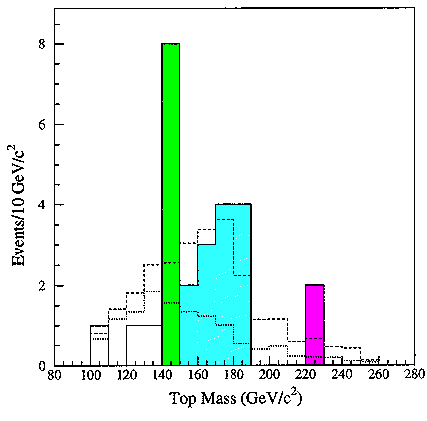
The Truth Quark, through its strong interaction with Higgs Vacua, may have two excited energy levels at 225 GeV and 173 GeV, above a ground state at 130 GeV. The 173 GeV excited state may exist due to appearance of a Planck-energy vaccum with < phi_vac2 > = 10^19 GeV in addition to the low-energy Standard Model vacuum with < phi_vac1 > = 252 GeV.
The mass of the Truth Quark is related to three different energy levels:
All three energy levels can be seen in Fermilab data, including the original Fermilab CDF Semileptonic histogram in FERMILAB-PUB-94/097-E, dated 26 April 1994:

and a similar 1997 Fermilab D0 Semileptonic histogram in hep-ex/9703008:
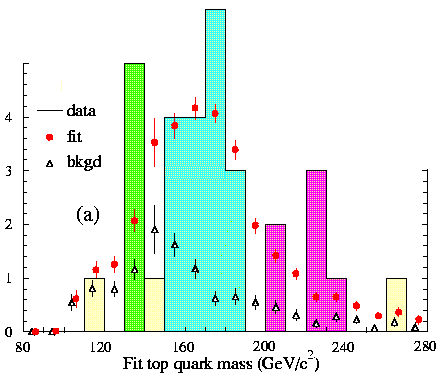
In both histograms the green bars the 130 GeV range containing Semileptonic events deemed insignificant by Fermilab's analysts, but considered by me to represent the Truth quark;
the cyan-blue bars represent bins in the 173 GeV range containing Semileptonic events interpreted as Truth Quarks by D0; and
the magenta bars represent bins in the 225 GeV range containing Semileptonic events not considered by Fermilab's analysts or by me as corresponding to either 130 GeV or 173 GeV Truth Quarks.
Rather than ask:
it may be more useful to ask:
Consider the Higgs mass - Truth Quark mass plane, based on Fig. 3 of Froggatt's paper hep-ph/0307138:
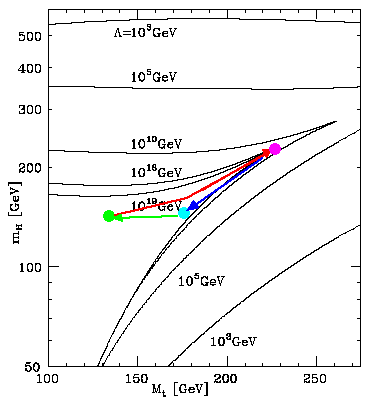
The green dot corresponds to a 130 GeV Truth Quark low-energy Standard Model one-vacuum ( < phi_vac1 > = 252 GeV ) ground state that is well within the Stability Region below the Triviality Bound and above the Vacuum Stability bound for a Standard Model with a high-energy cut-off that goes all the way to the Planck energy 10^19 GeV.
If accelerator-event collisions deposit up to 95 GeV of extra energy into a Truth Quark, it will be pumped up along the red curve within the Stability Region until it hits the Standard Model Critical Point at the magenta dot, where it will be a Standard Model Truth Quark excited state with mass-energy 225 GeV.
Since the 225 GeV Standard Model Truth Quark excited state is at a Critical Point, which is by definition on the Vacuum Stability curve, the one low-energy Standard Model vacuum ( < phi_vac1 > = 252 GeV ) is no longer stable, and a new vacuum phi_vac2 forms.
In my physics model, the new vacuum phi_vac2 appears at the Planck energy, where the low-energy Standard Model, Higgs, and Gravity with 4-dimensional Physical Spacetime makes a transition to a more unified structure with a Spin(1,7) gauge boson Lie algebra, fermion spinors from a Cl(1,7) Clifford algebra, an 8-dimensional Spacetime, and a corresponding high-energy vacuum with < phi_vac2 > = 10^19 GeV = Planck energy.
When the second vacuum phi_vac2 appears, the structure of the Standard Model is altered ( as explained by Froggatt ) so that the new Critical Point is at a 173 GeV Truth Quark mass, so the magenta dot 225 GeV excited Truth Quark state decays, moving along the blue curve along the Vacuum Stability bound to an intermediate excited state at the cyan dot at a Truth Quark mass of 173 GeV.
If the region around the Truth Quark does not have enough energy-density to maintain the second Planck energy phi_vac2 vacuum ( as is the case with present-day colliders that can do Truth Quark experiments ) then the cyan dot 173 GeV intermediate excited Truth Quark state decays along the green curve to the more stable Truth Quark low-energy Standard Model one-vacuum ground state at constituent mass of 130 GeV, the green dot.
There are some actual Fermilab events that seem to me to show that process in action. They are dilepton events, for which I would normally expect to see 2 jets in addition to the 2 leptons. However, some of the 6 D0 dilepton events described in the 1997 UC Berkeley PhD thesis of Erich Ward Varnes and in hep-ex/9808029 have 3 jets, and I will here discuss the kinematics of two of those events to illustrate the above-described Truth Quark - Higgs - Vacua process.
Here are the Kinematics of two of the 6 D0 Dilepton events, from Appendix B.2 of the 1997 UC Berkeley PhD thesis of Erich Ward Varnes. (Similar kinematic data are presented in D0 August 1998, hep-ex/9808029.) In the Varnes Kinematics tables, there are two numbers for each jet: one is energy after CAFIX corrections; and the second (in parentheses) is energy after post-CAFIX corrections.
The first dilepton event, Run 84395, Event 15530 ( mu mu ), as analyzed using the neutrino weighting algorithm,
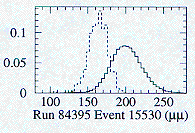
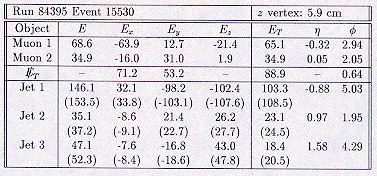
has, if all 3 jets are included ( the solid line in the graph ), energy around 200 GeV, corresponding to the Standard Model Critical Point Truth Quark excited state at the magenta dot.
If only the 2 highest energy jets are included ( the dashed line in the graph ), it has energy around 170 GeV, corresponding to the 2-vacuum intermediate excited Truth Quark state at the cyan dot, and the energy of the third jet would correspond to the decay down the blue curve along the Vacuum Stability bound.
This same event, if analyzed usingthe matrix-element weighting algorithm that, according to hep-ex/9808029, "... is an extension of the weight proposed in [R.H. Dalitz and G.R. Goldstein, Phys. Rev. D45, 1531 (1992)] ...",
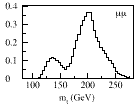
indicates the eventual decay into the Truth Quark low-energy Standard Model one-vacuum ground state at constituent mass of 130 GeV at the green dot.
The other dilepton event that I will discuss is Run 84676, Event 12814 ( e mu ), as analyzed using the neutrino weighting algorithm:
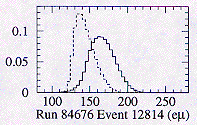
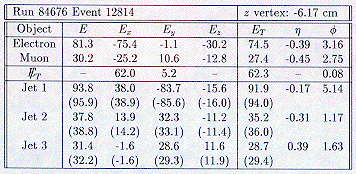
It has, if all 3 jets are included ( the solid line in the graph ), energy around 170 GeV, corresponding to the 2-vacuum intermediate excited Truth Quark state at the cyan dot.
If only the 2 highest energy jets are included ( the dashed line in the graph ), it has energy around 130 GeV, corresponding to the Truth Quark low-energy Standard Model one-vacuum ground state at constituent mass of 130 GeV at the green dot, and the energy of the third jet would correspond to the decay down the green curve.
C. D. Froggatt, in hep-ph/0307138, explained some of the relationships among the
"... It is only the top quark which has a mass of order the electroweak scale < phi_ws > = 246 GeV and a Yukawa coupling of order unity. All of the other charged fermion masses are suppressed relative to the natural scale of the SM [Standard Model]. ... the self-consistency of the pure SM up to some physical cut-off scale /\ imposes constraints on the top quark and Higgs boson masses.
- The first constraint is the so-called triviality bound: the running Higgs coupling constant lambda(mu) should not develop a Landau pole for mu < /\.
- The second is the vacuum stability bound: the running Higgs coupling constant lambda(mu) should not become negative leading to the instability of the usual SM vacuum.
These bounds are illustrated ... in Fig. 3 ...
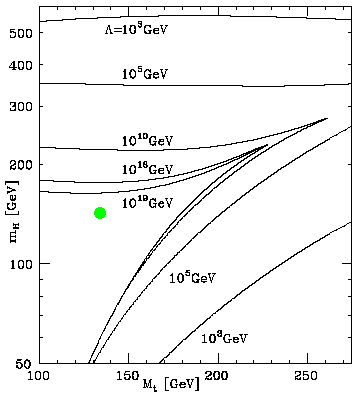
[ I modified Fig. 3 by adding the green dot, indicating the Truth Quark and Higgs masses predicted by my theoretical model in the context of the Standard Model and a single Higgs vacuum. ]
... where the combined triviality and vacuum stability bounds for the SM are shown for different values of the high energy cut-off /\. The allowed region is the area around the origin bounded by the co-ordinate axes and the solid curve labelled by the appropriate value of /\. In the following we shall be interested in large cut-off scales /\ = 10^15 - 10^19 GeV, corresponding to the grand unified (GUT) or Planck scale. The upper part of each curve corresponds to the triviality bound. The lower part of each curve coincides with the vacuum stability bound and the point in the top right hand corner, where it meets the triviality bound curve, is the quasifixed infra-red fixed point for that value of /\. ...
... one finds an effective infrared stable quasifixed point at the scale mu = mt, where the QCD gauge coupling constant ... is slowly varying ... The quasifixed point prediction of the top quark mass is based on two assumptions: (a) the perturbative renormalisation group equations are valid up to some high (e. g. GUT or Planck) energy scale /\ = 10^16 - 10^19 GeV, and (b) the top Yukawa coupling constant is large at the high scale ... Neglecting the lighter quark masses and mixings, which is a good approxmation, ... [t]he nonlinearity of the renormalisation group equations then strongly focuses ...[the top Yukawa coupling constant] ... at the electroweak scale to its quasifixed point value. We note that while there is a rapid convergence to the top Yukawa coupling fixed point value from above, the approach from below is much more gradual. The renormalisation group equation for the Higgs self-coupling ... similarly focuses lambda(mu) towards a quasifixed point value, leading to the SM fixed point predictions ...for the running top quark and Higgs masses:
- mt = 225 GeV
- mH = 250 GeV
... According to ... the Multiple Point Principle (MPP) ... nature chooses coupling constant values such that a number of vacuum states have the same energy density. ... This scenario is discussed in more detail in Holger Nielsen's lectures ... This MPP assumption, of course, explicitly introduces a fine-tuning mechanism, namely the degeneracy of the vacua. We shall use MPP ... to predict the top quark and SM Higgs masses, by postulating the existence of a vacuum state at the fundamental (Planck) scale < phi_ws > = /\_Planck = 10^19 GeV degenerate with the usual SM vacuum having < phi_ws > = 246 GeV. ... The application of the MPP to the pure Standard Model ... with a cut-off close to /\_Planck, implies that the SM parameters should be adjusted, such that there exists another vacuum state degenerate in energy density with the vacuum in which we live. This means that the effective SM Higgs potential Veff ( phi_ws) should have a second minimum degenerate with the well-known first minimum at the electroweak scale < phi_ws > = phi_vac1 = 246 GeV. Thus we predict that our vacuum is barely stable and we just lie on the vacuum stability curve in the top quark, Higgs particle (pole) mass (Mt, MH) plane. Furthermore we expect the second minimum to be within an order of magnitude or so of the fundamental scale, i.e. < phi_ws > = phi_vac2 = /\_Planck. In this way, we essentially select a particular point on the SM vacuum stability curve and hence the MPP condition predicts precise values for Mt and MH. .. Their values at the electroweak scale give our predicted combination of pole masses ... :
- Mt = 173 ± 5 GeV
- MH = 135 ± 9 GeV
... Note that the top quark mass, Mt = 174 ± 5 GeV, measured at FermiLab is interpreted as the pole mass. ...".
The Multiple Point Principle (MPP) is further described in hep-ph/9511371 by C. D. Froggatt and H. B. Nielsen, where they say:
"... For some time ... we have put forward the idea that Nature should choose coupling constant values such that several "phases" can coexist, in a very similar way to the stable coexistence of ice, water and vapour (in a thermos flask for example) in a mixture with fixed energy and number of molecules. This assumption is what we called the "multiple point criticality principle". Now it is well-known that the pure Standard Model, with one loop corrections say, can have two minima in the effective Higgs field potential. If really there were some reason for Nature to require phase coexistence it would be expected that the "vacua" corresponding to these minima should be able to energetically coexist, which means that they should be degenerate. That is to say the effective Higgs potential should take the same value in the two minima: V_eff ( phi_min1 ) = V_eff ( phi_min2 ). This condition really means that the vacuum in which we live is just barely stable; we are just on the border of being killed by vacuum decay. ... In the analogy of the ice, water and vapour system, the important point for us is that by enforcing fixed values of the extensive quantities, such as energy, the number of moles and the volume, you can very likely come to make such a choice of these values that a mixture has to occur. In that case then the temperature and pressure ( i.e. the intensive quantities) take very specific values, namely the values at the triple point. We want to stress that this phenomenon of thus getting specific intensive quantities only happens for first order phase transitions, and it is only likely to happen for rather strongly first order phase transitions. By strongly first order, we here mean that the interval of values for the extensive quantities which do not allow the existence of a single phase is rather large. Because the phase transition between water and ice is first order, one very often finds slush (partially melted snow or ice) in winter at just zero degree celsius. And conversely you may guess with justification that if the temperature happens to be suspiciously close to zero, it is because of the existence of such a mixture: slush. But for a very weakly first order or second order phase transition, the connection with a mixture is not so likely. In the analogy considered in this paper the coupling constants, such as the Higgs self coupling and the top quark Yukawa coupling, correspond to intensive quantities like temperature and pressure. If the vacuum degeneracy requirement should have a good chance of being relevant, the "phase transition" between the two vacua should be strongly first order. That is to say there should be an appreciable interval of extensive variable values leading to a necessity for the presence of the two phases in the Universe. ... If, as we shall assume, Planck units reflect the fundamental physics it would be natural to interpret this strongly first order transition requirement to mean that, in Planck units, the extensive variable densities ... for the two vacua should differ by a quantity of order unity. Phenomenologically we know that | phi |^2 is very small in Planck units for the vacuum in which we live, and thus the only way to get the difference of order unity ( or larger) is to have the other vacuum have | phi |^2 of the order of unity in Planck units ( or larger). From the philosophy that Planck units are the fundamental ones, we should really expect the average | phi |^2 in the other phase just to be of Planck order of magnitude. It is the main point of the present article to compute the implications of the following two assumptions, which could naturally be satisfied according to the above fixed extensive quantity argument:
- a) The two minima in the Standard Model effective Higgs potential aredegenerate: Veff ( phi_min1 ) = Veff ( phi_min2 ).
- b) The second minimum, which is not the one in which we live, has a Higgs field or Higgs field squared of the order of unity in Planck units ...[this assumption is]... what we called the "strong first orderness of the phase transition". ...
... If we take it that the top mass agreement and the acceptable Higgs mass prediction are not accidental, then we must accept the crucial content of the assumptions:
- 1. The pure Standard Model is valid up to the Planck scale, at least as far as the top quark and Higgs interactions are concerned. This would mean that no new physics interacts significantly with the top or Higgs particles before the Planck scale; in particular supersymmetry would not be allowed.
- 2. There is a need for some physical explanation of the principle of degenerate phases. This means that we either have some coexistence of phases in space or more likely in spacetime (the latter threatening locality, e.g. baby universes) or we need another mechanism doing the same job. ... our effective coupling constant(s) - we here really think of m_H1^2 the bare Higgs mass squared - gets possibly influenced, for instance, from the future or from very far away places and times. This is really the same effect as in baby universe theory ... The baby universes quite obviously cause connections between far separated space time points, without any restriction as to whether that may allow the future to influence us (especially the value of the coupling constants). In fact the considerations of this section can be considered as a derivation of our prediction for the top and Higgs masses from a class of models containing baby universe theory as a special case. ...".
Some related material and references can be found on my home page on the web at URL
http://www.innerx.net/personal/tsmith/TShome.html
and on pages linked therefrom.
A web URL for this html paper is
http://www.innerx.net/personal/tsmith/TQvacua.html
......